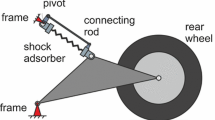Abstract
The study of racing car suspension is always a key issue when looking for improvements in car performance [1–4]. The experience, knowledge and data obtained in operational conditions is analysed through simulation, allowing adjustments in the car set-up. An advanced design solution is the implementation of a double opposing spring system, commonly used in Formula 1, in LMP1 or LMP2 but not in minor racing [5], named “contractive suspension”. Such designs integrate an additional spring in the damper system to push the tire down into the ground and increase the understeer effect, thus correcting the setup of the antiroll bar. A study was carried out on a Hill-Climb Race Car, starting from the full vehicle multi-body model of the car with the complete front and rear suspensions. The vehicle was simulated running on an uphill track with the primary manoeuvre bring low-speed cornering with high lateral and longitudinal accelerations. To find the best stiffness ratio between front and rear, a contractive mathematical model has been implemented. Simultaneously, the mechanical design process started with the objective of designing a compact system with elastic elements that could be easily replaced and inserted in place of the traditional spring-damper solution. The results, primarily performed in multibody simulation environment and then verified by the measurement data acquired from on the track, showed an improvement in terms of load transfer at contact patch wheel area with respect to the traditional set-up solution. The evident reduction of the vibration level of the wheel with corresponding increase of traction is confirmed by the pilot, who had a better feeling of the car in comparison to the existing solution. Finally, improvement of the mechanical system helped set-up operations during the racing and to achieve weight reduction and space optimization for aerodynamic scope. In conclusion, the adoption of the multibody simulation has been the key aspect to design, verify and optimize all possible variant set-ups before the test phase. Although it is always needed a series of tests for the final tuning, simulation has enormously decreased the time and cost requirements for the experimental development activity, allowing identifying a selected number of optimized set-up solutions.
F2012-E04-014
Access this chapter
Tax calculation will be finalised at checkout
Purchases are for personal use only
Similar content being viewed by others
References
Gillespie TD Fundamental of vehicle dynamics. SAE International, ISBN 978-15-609-1199-9
Genta G (2000) Meccanica dell’autoveicolo, Levrotto and Bella, ISBN 978-88-821-8042-3
Milliken WF, Milliken DL (1995) Race car vehicle dynamics. Soc Automot Eng. 367–372 ISBN 1560915269
Guiggiani M (2007) Dinamica del veicolo. De Agostini Scuola Spa, ISBN 978-88-251-7300-0
Staniforth A (2006) Competition car suspension: a practical handbook. Haynes Publishing, ISBN 1844253287
Smith C (2004) Racing chassis and suspension design. Soc Automot Eng ISBN 0768011205
Smith C (1978) Tune to win. Aero Publishers, ISBN 0879380713
Jazar RN (2008) Vehicle dynamics: theory and applications. Springer, Berlin, ISBN 0387742433
Dixon JC (2009) Suspension geometry and computation. Wiley, New York, ISBN 978-0-470-51021-6
Dixon JC (2007) The shock absorber handbook. Wiley, New York, ISBN 978-0-470-51020-9
Bianchi M (1993) Suspension process and apparatus of the type having different stiffnesses with provision to smooth the change from one stiffness to another. US5183285
Bianchi M (1993) Vehicle wheel suspension method. US5244190
Bianchi M (1993) Suspension of vehicle using two stiffnesses, adapted respectively for obtaining a good level of comfort and a good level of behaviour. US5263695
Bianchi M (2001) Vehicle wheel suspension using spring combined with flexible armouring for modifying the stiffness curve. US6237901
Tesi di F Raimondi Studio e realizzazione di una sospensione contrattiva. Università degli Studi dell’Aquila, Anno accademico 2007–2008, Relatore Prof. Ing. De Paulis A, Tutor aziendale Ing. Carfagna G
Fuke WA (1968) Variable rate suspension. US3417986
Joseph L (1972) Spacer and stabilizer for insertion between adjacent convolutions of an automobile coil spring. US3674250
Moehle KA, Taschner RG (1977) Dual spring support. US4033542
Milliken WF, Milliken DL (2002) Chassis design: principles and analysis. Professional Engineering Publishing, ISBN 978-1-860-58389-6
Genta G, Morello L (2009) The automotive chassis. Components design, vol 1. Springer, Berlin, ISBN 978-1-4020-8674-8
Genta G, Morello L (2009) The automotive chassis. System design, vol 2. Springer, Berlin, ISBN 978-1-4020-8673-1
Gilles T (2004) The automotive chassis: brakes, suspension and steering. Cengage Learning, ISBN 1401856306
Juvinall R, Marshek K (2002) Fondamenti della progettazione dei componenti delle macchine. edizioni ETS, ISBN 978-88-774-1730-5
et altri Andreini P (2005) Manuale dell’ingegnere meccanico. Hoepli, ISBN 978-88-203-3380-5
Zagatti E, Zennaro R, Pasqualetto P (1994) L’assetto dell’autoveicolo, sospensioni, pneumatici, sterzatura, comportamento dinamico. Levrotto and Bella, ISBN 978-88-821-8022-5
Reimell J, Stoll H, Betzler JW (2001) The automotive chassis. Butterworth Heinemann, ISBN 0750650540
Adams H (1993) Chassis engineering. Penguin, ISBN 1557880557
Wood JK (1943) Variable support hanger. US2335834
Wood JK (1948) Support. US2437631
Fenton AJ (1961) Lowering device applicable to automobile springs. US3014713
Hines JE (1967) Combination shock absorber and spring. US3297312
Author information
Authors and Affiliations
Corresponding author
Editor information
Editors and Affiliations
Rights and permissions
Copyright information
© 2013 Springer-Verlag Berlin Heidelberg
About this paper
Cite this paper
Pierluigi, A., Valerio, C. (2013). Design and Development of Contractive Suspension in Hill-Climb Races. In: Proceedings of the FISITA 2012 World Automotive Congress. Lecture Notes in Electrical Engineering, vol 195. Springer, Berlin, Heidelberg. https://doi.org/10.1007/978-3-642-33835-9_49
Download citation
DOI: https://doi.org/10.1007/978-3-642-33835-9_49
Published:
Publisher Name: Springer, Berlin, Heidelberg
Print ISBN: 978-3-642-33834-2
Online ISBN: 978-3-642-33835-9
eBook Packages: EngineeringEngineering (R0)




